After missing for two years, Paris Japan Expo was finally held again at the Villepinte Parce des Expositions. For this edition, called the phoenix edition, to express the event’s resurrection, one of the guests of honor was the director, animation director, and animator Yukio Takatsu.
Yukio Takatsu is best known for directing various opening animations for video games and anime, his most famous being his contributions to Persona 3 and multiple installments of the Monogatari series.
I met Mr. Takatsu for the first time during the Annecy International Animation Film Festival in 2017. After meeting again in Paris, where he had just moved earlier that year, we became close friends, so when asked to hold a panel at Paris Japan Expo about his career, he asked me to host the conference alongside him.
The panel’s goal was to introduce the audience to Yukio Takatsu’s works as a director and give them a grasp on what makes his work distinctive and identifiable, and also share various anecdotes about the production of his works and his influences. A more personal goal was for Mr. Takatsu to hold the panel entirely in French, as he has been practicing thoroughly to speak the language fluently. I am very happy that he was able to succeed in this goal.
The flow of the panel is based on the drafts of an article I started writing about his works in 2017. It was never released as I was not satisfied with the results of what I wrote, so I am happy that I was able to share my appreciation for Mr. Takatsu’s work in this form.
The following transcription of the panel has been slightly modified, as I have taken the liberty to add some information that Mr. Takatsu shared during our rehearsal but didn’t cover when on stage.
Like our content? Feel free to support us on Ko-Fi!
Dimitri Seraki: Welcome, everyone. Thank you all for attending this panel. I am honored for this opportunity to stand here alongside Mr. Yukio Takatsu and present to you his work. Also, Mr. Takatsu decided to try holding this panel entirely in French for you all. Please give a big round of applause to Mr. Takatsu!
Yukio Takatsu: Hello, everyone. My name is Yukio Takatsu. I am a director, animator, and animation director.
Today we will focus on one particular aspect of his career: the openings he has directed and animated, as they are his most personal works, reflecting who he is as an artist.
But before we get to your first works, can you first tell us about how you decided to become an animator?
Yukio Takatsu: When I was a child, I watched the original Mobile Suit Gundam series, which sparked my interest in drawing and animation. I became an otaku. Later, in high school, I was very passionate about shows such as Samurai Troopers.
That’s why after high school, you attended the Yoyogi Animation School.
Yukio Takatsu: Yes, there weren’t many other options if you wanted to become an animator at the time, so I went there.
After graduating, you start your professional career by joining the studio Miyuki Production. Most people probably don’t know about Miyuki Pro. It was a small structure that mostly did subcontracting work. Can you tell us a bit about how your beginnings were?
Yukio Takatsu: When I joined Miyuki Production, only three people were left working there.
Only three? That’s not a lot!
Yukio Takatsu: Right? Most of their animators had quit just before I started working there. There were some very talented ones among them. But at the same time I entered, about ten other people joined.
Did you have some mentors at Miyuki Pro?
Yukio Takatsu: I had a supervisor for a brief time, but because most of the qualified staff had left, there weren’t enough people who could take on such responsibilities. I was very quickly left on my own.
So you did some work at Miyuki Pro, then you left to join Daizo Production, a very similar structure.
Yukio Takatsu: Yes. But they are very small studios, nobody knows about them.
And then, you decide to quit animation, is that right?
Yukio Takatsu: For about a month, I quit making anime while taking driving lessons to get my driver’s license. I wanted to stop making anime and become an engraver! But you can’t make a living with that work, so I gave up and went back to work on anime.
When you start working as an animator again, you decide to go freelance and work closely with studio Trans Arts.
Yukio Takatsu: I was asked to do some key animation for Revolutionary Girl Utena. At first, I considered turning down the offer, but I am a fan of the composer of the show, Mr. Mitsumune Shinkichi, so I made up my mind and accepted.
At the start of the 2000s, you started collaborating very closely with studio Point Pictures, created by one of the producers you worked with at Trans Arts.
Yukio Takatsu: That’s right.
The particularity of Point Pictures is that it specializes in short productions such as commercials, music videos, and anime and video game openings. And one of the first projects you direct and storyboard on which you have a lot of creative freedom is the opening animation for the video game Persona 3.


I think one of the first noticeable aspects of your works, a very striking one, is your sense of framing and image composition. One of the ways you create engaging visuals is through the use of text. Can you tell us more about the ideas and reasons behind it?
Yukio Takatsu: It’s difficult to explain, but I will try my best. When I work for an opening, I try to approach the video the same way a music composer would with his music. When I arrange the image, I envision it like a music sheet. The texts are one of the “notes” I use, and so are images, particles, and so on. I always keep the music in mind, which is one way for me to adapt the music into visuals. Also, I am a bit ashamed to admit it, but using texts means I have to draw less, which is very convenient.
How much time did it take you to make the Persona 3 Opening?
Yukio Takatsu: I had a very short schedule at the time. I only had three days to draw everything.
Only three days? No wonder you tried to find smart ways to draw less! It must have been hard.
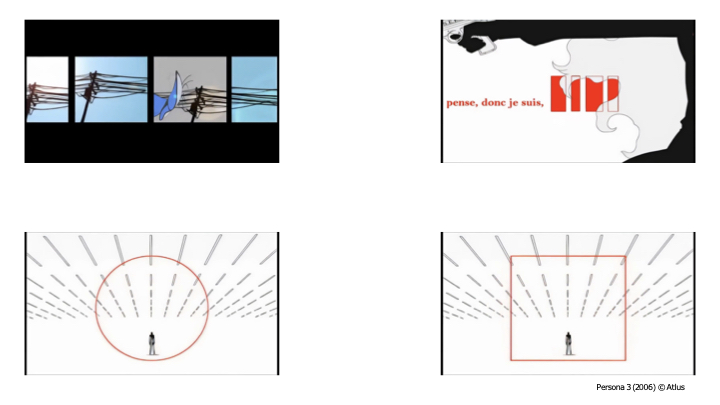

Another noticeable aspect of your work, which will be a recurring feature throughout your works, is the use of geometrical figures and the way you frame characters within them. This way of dividing the screen reminds me a lot of Yoshiyuki Tomino’s way of directing, especially in Z Gundam. Since you mentioned that it was Gundam that sparked your interest in animation, is it an influence of yours?
Yukio Takatsu: I had never thought of it this way, so I wouldn’t say that it is. But I watched so much Gundam as a kid that it might have left such a big impression on me that I would have taken it in subconsciously and wouldn’t even noticed it. I would rather say my inspirations regarding frame composition come from Stanley Kubrick.
It was just a theory of mine. It seemed like an obvious comparison to make, but I might have overthought it.

Then there is this moment, which is my favorite part about the opening. You apply a texture to animate within the wall of text which I find very original and appealing. But this wasn’t intended this way at first, is that right?
Yukio Takatsu: My original intention for the opening was to do something very minimalistic. So there wasn’t any text in this scene. But at the time, such minimalist work wasn’t common, so the client didn’t understand what I had in mind. The client asked me to add elements to it. I put a lot of thought into it and took inspiration from music videos. I’m not sure it was for this scene, but I remember taking inspiration from clips by Michel Gondry. I loved watching music videos during that period, so I took a lot of inspiration from them.
Are there any particular reasons that led to you working on Persona 3?
Yukio Takatsu: I don’t get to choose for myself what I get to work on; I choose from what comes to me. But in the case of Persona, I love movies with a dark, serious tone. That’s something you rarely find in animation, so I was happy to be able to work on something with such an atmosphere.
Persona takes a lot of inspiration from David Lynch’s Twin Peaks, which you are a great fan of.
Yukio Takatsu: Yes! I kept it to myself, but it was my favorite part of working on Persona 3!

And you didn’t only work on the opening for the game but also storyboarded its cutscenes. And there is this particular scene I would like to talk about, which is an homage to episode 13 of Ultraman Ace. It’s a very famous scene from which Hideaki Anno also took inspiration for his show Neon Genesis Evangelion. But the crosses in the Persona 3 scene aren’t Christian crosses. Are there any particular reasons for it?
Yukio Takatsu: It is because of, how do you call it again? Political correctness? The client intended to release the game overseas, especially in the USA. They were afraid that such imagery would cause backlash from religious associations and might get the game censored. So they asked to remove the Christian imagery.



I see. The following work we will discuss is your Opening for Tantei Opera Milky Holmes, a PSP game released in 2010. More precisely, it’s the second opening of the game, which one unlocks when they get to the last chapters. I chose to talk about this work because we find all those elements we pointed out in the Persona 3 Opening. The way you frame the characters, the use of texts – in this case, the title of various stories of Arsène Lupin and Sherlock Holmes. Did you draw everything for this opening?
Yukio Takatsu: No! I didn’t draw at all. I used assets from the game and animation from the TV Show. I had access to a large bank of images and animation. There was so much that it was hard to choose from.
And how much freedom did you have? Could you just do anything you wanted with them?
Yukio Takatsu: I had complete freedom over it. What happened is that when I gave the storyboard to the clients, they didn’t understand what I had in mind, and there wasn’t any time to make a new one, so they just told me to do whatever I wanted.



A new aspect that makes up the identity of your work appears in this opening: your use of symmetry which results in these kaleidoscopical visuals. It’s the main reason I chose to talk about it. Is there a particular reason why you like to play with symmetry?
Yukio Takatsu: The main reason is that I try to put in my work ideas that I think are visually interesting. But it’s also a trick that allows me to fill the screen by drawing less, like the texts.

Next, I want us to look at your opening for the game Atelier Ayesha from the Atelier JRPG series. This one is much less dark and has a calm, soothing tone.


Once again, we find those elements we were talking about: the use of text and geometrical figures, this time with some morphing animation to them. The game revolves a lot around flowers and botany, and the feeling I get from this work is almost synesthetic. We will review it quickly because we don’t have too much time and many topics to cover, but I wanted to stress how your style developed through time and how identifiable aspects took ground.

On your video game openings, there always is a traveling scene with a virtual camera moving in a 3D space, which is used to introduce the characters.
Yukio Takatsu: Honestly, I hadn’t even noticed that it was a recurring aspect. (laughs)
It’s a very effective way to do it, so maybe you would just do it without thinking about it.
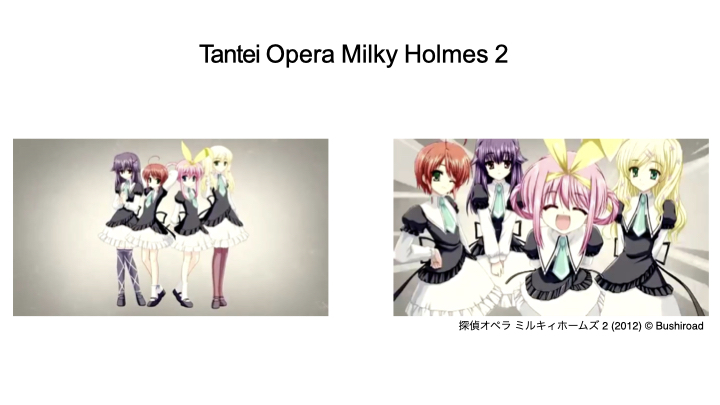
The subsequent video game work is the opening to Tantei Opera Milky Holmes 2. Like the first one, this opening gets unlocked in the game’s later stages. In my opinion, it was important to showcase this one because it allows noticing how your style evolved over time. Just like the first one, you didn’t do any of the drawings, is that right?
Yukio Takatsu: Exactly, I used bits from the TV shows.


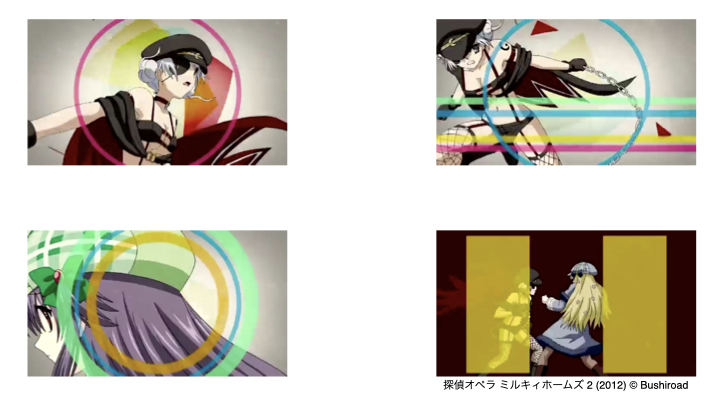
The use of symmetry this time really is kaleidoscopical. Also, the way you use the geometrical forms to frame the action and enclose it to parts of the screen is fascinating.
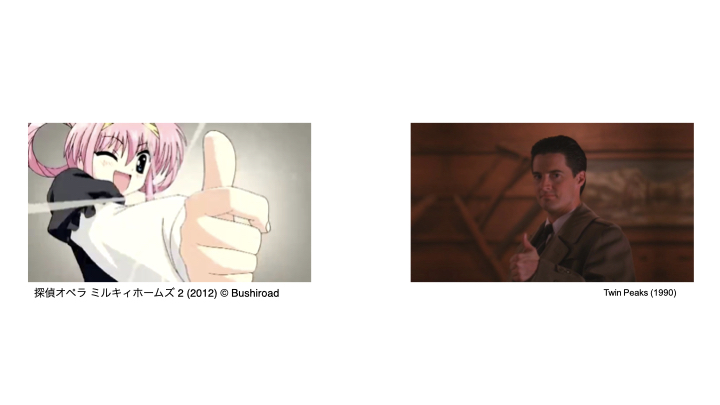
Also, I couldn’t help but notice. Is this an hommage to Twin Peaks?
Yukio Takatsu: (laughs) No, not at all. As I said, I didn’t do any of the drawings.
Sorry, I couldn’t help making that joke.

Alongside those games, you also started to make openings on the Monogatari series, starting with Nisemonogatari. Can you tell us about the context leading to you working on it?
Yukio Takatsu: I was contacted by the president of Studio SHAFT, Mr. Kubota Mitsutoshi. He asked me if I was able to take such work.
Do you know if you were contacted following the request of Director Shinbou? I know that he loves video games. It’s seen especially in his show Starship Girl Yamamoto Yohko. I wouldn’t be surprised if he noticed your work playing a game you worked on.
Yukio Takatsu: I have no idea if it’s the case. Not to my knowledge, at least.

The Karen Bee one was the first opening you directed, storyboarded, and animated for the series. I think that now that we are looking at your work for the Monogatari series, the selection of works we have discussed to this point will make even more sense. Let’s once again take a look at some recurring elements. First of all, the framing and how you divide the screen. There’s also an amusing use of the credits here.
Yukio Takatsu: Yes, I noticed there was the kanji for “eye” (目) in the credits, so I chose to replace the character’s eye with the kanji.

Then there is once more the use of symmetry. This time accompanied by some great effects animation. Can you tell us more about the process for these?
Yukio Takatsu: For these ones, I drew a couple of explosion cycles and used some functions on After Effect to get this result. It’s the same cycles with different sizes and timings.


The various explosions you animated are beautiful. I was disappointed we couldn’t show the openings, but in this case, looking at the individual frames allows us to enjoy the art behind these explosions.

The same goes for this morphing sequence, where you would barely notice some of the drawings.
Yukio Takatsu: Yes, you can’t see the drawing when it’s moving, but it effectively conveys a strange impression to the viewer.
Frame by frame, one can really enjoy the smears.

And this time, there is an actual hommage to Twin Peaks, right?
Yukio Takatsu: Yes, the ground pattern is the same as in the Black Lodge.

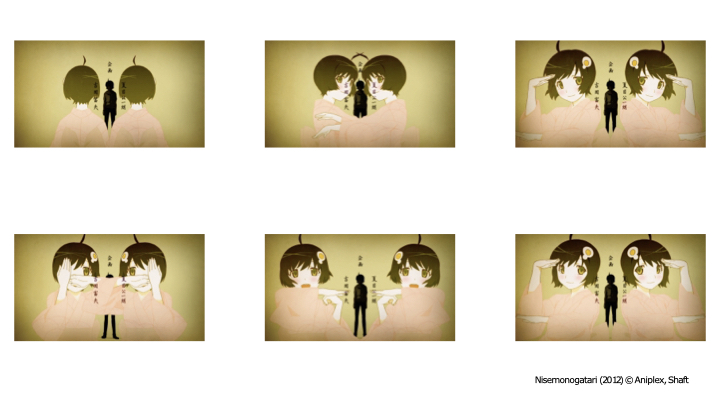

On Nisemonogatari, you were also in charge of the opening for the Tsukihi Phoenix part. On this one, you played a lot with symmetry once more. Also, I recall you telling me there is something special with the credits.
Yukio Takatsu: Yes, when listening to the music, I thought it would be great to go for a style that recalls traditional Japanese cinema, particularly the movies of director Yasujirou Ozu. I wanted the credits to look close to the credits of his films, but there wasn’t any font like that. So I asked a colleague of mine who studied calligraphy if she could draw the credits in this style.

The next opening in the series you work on is during Monogatari Second Season for the Koimonogatari part.


For this work, you collaborate with Osamu Kamijo, an iconic animator, animation director, and character designer from the ’80s. He was the character designer of Space Warrior Baldios and an influential animation director on Magical Princess Minky Momo. He takes a lot of influence from Studio Tatsunoko animators such as Tsuguyuki Kubo and Masami Suda and Gekiga anime with artists such as Araki Shingo. For example, in this scene from Space Warrior Baldios, you can see the influence of Araki’s work at the time of Star of the Giants in how he draws the character, the shading, and the thick lines. How did you meet Mr. Kamijo?
Yukio Takatsu: We met while he was working at Point Pictures. I thought an opening with a style reminiscing of the ’80s would suit the best, but I am not good at drawing characters in such a style, so I asked him if he would give me a hand.

The ’80s vibe is felt through various methods. First of all, there are the effects. There are a lot of Kanada Lightflares throughout the opening. They are named after Yoshinori Kanada, the most influential and important animator in the history of anime.
Yukio Takatsu: I had to use them. When you see them, you immediately think of the ’80s!
Did you watch animes Kanada worked on when you were a kid?
Yukio Takatsu: I think I often saw them either in theatres or on TV, but at the time, I didn’t know his name or what scenes he did.
But it was inevitable seeing them, right? Be it Genma Taisen or Galaxy Express 999.
Yukio Takatsu: Right!

So these are the designs Mr. Kamijo did of Senjogahara for the anime. The way she blushes looks the same as on his episodes of Minky Momo, with three or four lines drawn to show she is blushing.
Yukio Takatsu: Yes, he told me that he invented this way of drawing blush on characters!
The way he draws the chin and the eyes truly screams ’80s aesthetics too.
Yukio Takatsu: Every time he sent me his drawings for the key animation, I found them very amusing.

And when we take a look at the directing, we notice those same gimmicks we have been highlighting. You keep enclosing characters in those geometrical figures. This time, when they are enclosed in the figures, the style changes from contemporary to vintage style. I love the way you play with the codes that define your style.


One can also notice the opposition between more modern CG effects and ones reminiscent of older anime. The colors and highlights also help sell the ’80s aesthetic.
Yukio Takatsu: Yes, those are inspired by the style of the painter Seizo Watase, whose aesthetic is symbolic of the times. It reminds the economic bubble and more careless and prosperous times, which I thought fit the story.
So does the car depicted, a first-generation Mazda MX-5. It’s not an unfamiliar model to you.
Yukio Takatsu: I used to have the same Eunos Roadster car when I lived in Japan. But mine was dark green, not red. I love this car.
The pop-up lights are so cool!
Yukio Takatsu: Right? My favorite part is that it’s a convertible.
It’s my dream car too! (laughs)


Your next work on the Monogatari series is for Tsukimonogatari, with the part dedicated to the character of Yotsugi. In that opening, we can see you using this paper-like animation that you had already used when directing the opening of the game Para-Sol. Parasol is an adult erotic visual novel.
Yukio Takatsu: Yes, at the time of Para-Sol, I had seen that in a music video and wanted to try it out. I liked the idea a lot and wanted to use it again. Because Yotsugi is a Shikigami, a paper doll, I thought it was very fitting.

And in this opening, we find an hommage to Stanley Kubrick, who you mentioned as one of your influences earlier. The ground is the same as the hallway in The Shining.
Yukio Takatsu: Yes, I love this movie. And as I said, I am very influenced by his work, especially when it comes to frame composition. His work also inspires the symmetry effects I use.

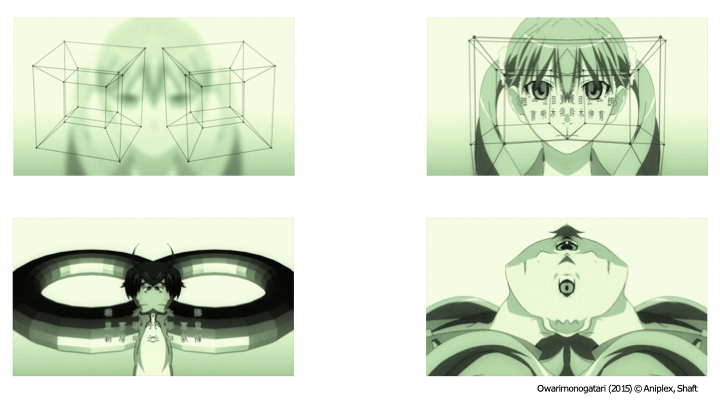
Let’s talk about your next work, the end of your collaboration on the Monogatari series, with your opening on Owarimonogatari.
Yukio Takatsu: This one is particularly symmetric! (laughs)
Yes! And it is very geometric too! I think that is a hypercube, am I right? A hypercube is a 4-dimensional cube, which would be what it looks like when transposed to the 3rd dimension.
Yukio Takatsu: Yes, that’s right! Since Sodachi is interested in maths, I wanted to take this opportunity to play with mathematical and geometrical concepts. I am very interested in Maths but am very bad at them and barely understand them.
Is there a field in Maths that interests you particularly?
Yukio Takatsu: I am very interested in the works of Pierre de Fermat, but I don’t understand them at all. (laughs)

In this work, the use of symmetry is omnipresent. We were talking about kaleidoscopical animation; I think this one is most representative of it.
So we have been trying to define the style of Mr. Takatsu’s work for the past half hour, and I think we have identified some clear elements that make up his style. And now comes the part where everything gets proven wrong.

Your next noticeable work is the opening you did for Naruto Shippuden, and the style changes completely. There aren’t any of the elements we have discussed to be found. The aesthetic takes a lot from traditional Japanese arts.


Yukio Takatsu: Yes, because Naruto is a story about ninjas and has a lot of elements from Japanese folklore and tales, I thought that taking inspiration from traditional arts such as Ukiyo-e and Nihonga would be fitting. Also, at the time, I was already planning my move to France, so going for a very Japanese style was my way of saying farewell to the country.
And did you read Naruto?
Yukio Takatsu: Yes, I had to read all the manga. I think I did it in about a week.
All of it in one week? All 70 volumes? Wasn’t it hard?
Yukio Takatsu: Too hard. I already forgot everything about it because I read it so fast!
I noticed that the credits are written in calligraphy as if it was painted on a scroll.
Yukio Takatsu: Yes, I worked with the same colleague I worked with for the credits of Nisemonogatari. I asked her to recreate the style found on old scrolls.

After working on Naruto, two big events happen in your life that impact your work. First of all, you moved to Paris. You also change the support you work with, start working on an iPad Pro, and start tinkering with this new tool. That results in your ending animation for March comes in like a lion.
Yukio Takatsu: Well, my environment changed, but I didn’t change my way of working. I have always worked alone, all by myself at home on my computer. That hasn’t changed. But when I get out, I’m in Paris!
Are you happy to live in Paris?
Yukio Takatsu: Yes, obviously! Except for the rent, it’s too high! (laughs)

So this work uses a water painting style which was done digitally. Even if it looks very different, some familiar aspects, such as these morphing sequences, still appear.
Yukio Takatsu: Yes, this kind of animation in Japanese is called Obake, like a ghost.

The beginning is very gloomy, using only black, white, and gray. And around the midway point, colors start to appear. The mood brightens up.
Yukio Takatsu: I wanted it to reflect the main character’s emotional change and growth. The music’s mood also changes at that point.
And even though the water painting aesthetic makes it look different, we can still find some of the familiar aspects we discussed earlier.
Your next work was another collaboration with studio SHAFT. It’s a commercial ordered by Toshima City and Animate to promote the Ikebukuro district, with character designs by Akio Watanabe. We will be showing it to you now.
The clouds in the clip are the same ones you used for Naruto! You are so lazy; you are recycling assets! (laughs)
Yukio Takatsu: No, I just wanted to go for that traditional Nihonga aesthetic again.
So Mr. Watanabe was the character designer and animation director on this one?
Yukio Takatsu: That’s right.
Isn’t it too hard working with him? I have heard that he is very demanding.
Yukio Takatsu: He usually makes a lot of corrections.
Did he make a lot on your work?
Yukio Takatsu: A little bit, yes.
He doesn’t dare to make corrections only when working with the Yoshinari brothers.

Finally, the last work we will discuss is the opening you did for the video game Haven. You worked with a French company on this project, is that right? How did it go?
Yukio Takatsu: Yes. It was nearly my first time working on a project with a French company. It wasn’t very different for me because I had a lot of freedom and worked alone from home. Maybe a significant difference is that I had to work using TV Paint software for this project.
What tools do you usually use? Are you still using paper?
Yukio Takatsu: I stopped using paper a few years ago already. I am farsighted, so using paper has become quite bothersome for me. Digital tools are more convenient.


And regarding the work itself, it has that similar water paint texture and aesthetic that you used in March comes in like a Lion. But it also uses a lot of those elements you have been using we discussed throughout this panel. The frame composition, the use of geometrical forms. I think it sums up the style and aesthetic you have built for yourself throughout the years that make your work stand out.
Yukio Takatsu: I don’t really want people to notice it.
[Somebody in the audience asks why that is]
Yukio Takatsu: I don’t want people to notice the font of my inspiration, so I don’t feel comfortable with people identifying a style to my work.
I guess we are fated to be sworn enemies, then!
Are there any last words you’d like to share with fans here in France?
Yukio Takatsu: I wonder what I could say.
Maybe something nice about France? (laughs)
Yukio Takatsu: It’s already been five years since I moved to France. I love living here in Paris. French people have been very welcoming and friendly. Especially anime fans and animators have a lot of respect for Japan, and I am very grateful for that.
I would like to take the time to thank the following people:
Yukio Takatsu for his friendship and for trusting me in this task alongside him.
Fabrice Renault for giving us the opportunity to hold this panel.
My dear friends Matteo Watzky, Ludovic Joyet, and Bruno De La Cruz for their support and help preparing this panel.
The whole staff at Paris Japan Expo for their kindness and availability throughout the event.
And lastly I wish to thank everyone who attended the panel.
Like our content? Feel free to support us on Ko-Fi!
You might also be interested in
Benoît Chieux, a career in French animation [Carrefour du Cinéma d’Animation 2023]
Aside from the world-famous Annecy Festival, many smaller animation-related events take place in France over the years. One of the most interesting ones is the Carrefour du Cinéma d’Animation (Crossroads of Animation Film), held in Paris in late November. In 2023,...
Directing Mushishi and other spiraling stories – Hiroshi Nagahama and Uki Satake [Panels at Japan Expo Orléans 2023]
Last October, director Hiroshi Nagahama (Mushishi, The Reflection) and voice actress Uki Satake (QT in Space Dandy) were invited to Japan Expo Orléans, an event of a much smaller scale than the main event they organized in Paris. I was offered to host two of his...
Akira stories – Katsuhiro Otomo and Hiroyuki Kitakubo talk at Niigata International Animation Film Festival 2023
Among the many events taking place during the first Niigata International Animation Film Festival was a Katsuhiro Otomo retrospective, held to celebrate the 45th anniversary of Akira and to accompany the release of Otomo’s Complete Works. All of Otomo’s animated...





Trackbacks/Pingbacks